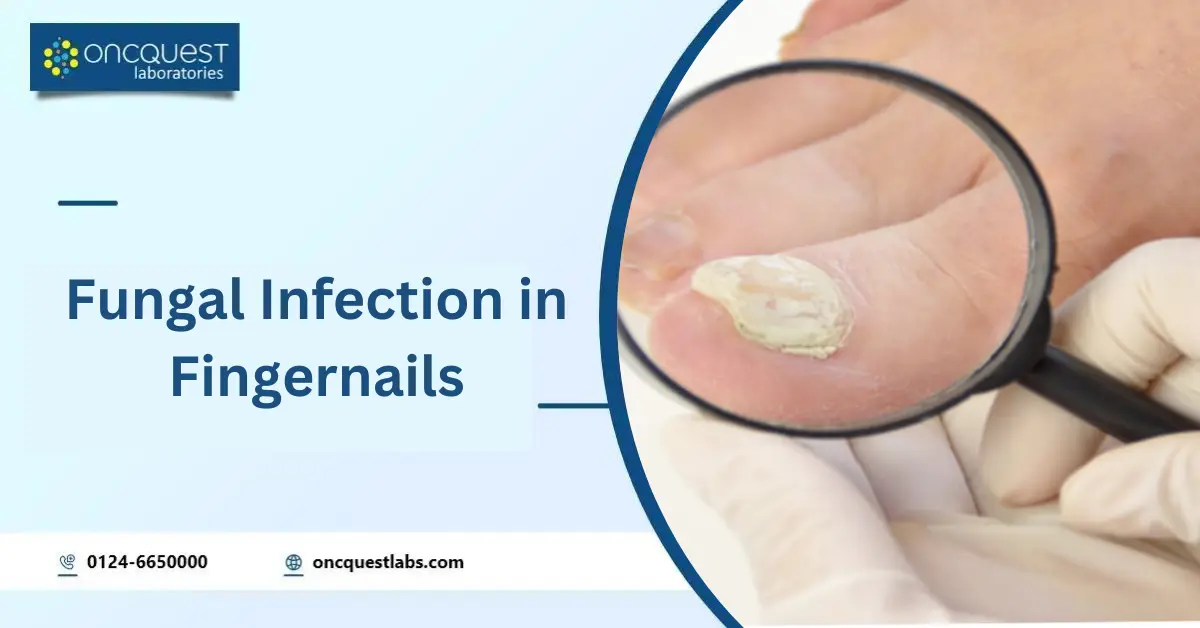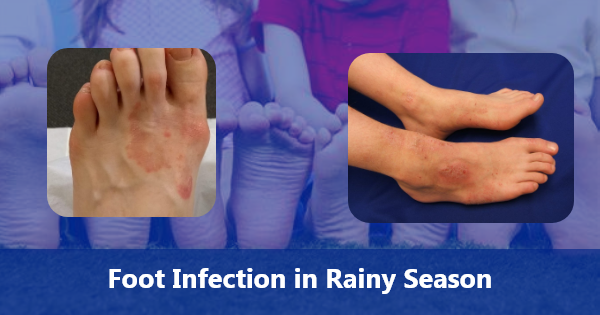Nail fungus, also known as onychomycosis, is a common nail infection that typically starts as a white or yellow-brown spot beneath the nail tip. As the fungus progresses, nails can become discolored, thickened, and prone to crumbling at the edges. This condition can affect multiple nails simultaneously.
For mild cases that aren’t bothersome, treatment may not be necessary. However, if the fungus causes pain and leads to thickened nails, self-care measures and medications can be beneficial. It’s worth noting that even with successful treatment, nail fungus can recur.
Additionally, when the fungus affects the areas between toes and the skin of the feet, it’s termed athlete’s foot or tinea pedis.
Contents
- 1 Symptoms of Fungal Fingernail Infection
- 2 Causes of Fungal Fingernail Infection
- 3 Risk Factors of Fungal Fingernail Infection
- 4 Treatment for Fingernail Fungus?
- 5 Complications for Fungal Fingernail Infection
- 6 Prevention of Fungal Fingernail Infection?
- 7 What kills nail fungus fast naturally?
- 8 When to see a doctor
- 9 Frequently asked questions
Symptoms of Fungal Fingernail Infection
- Thickened Nails: The affected nails become thicker than usual, which can lead to discomfort and difficulty in trimming or maintaining them.
- Discolored Nails: Nails may develop white, yellow, or brownish discoloration, indicating the presence of fungal infection underneath.
- Brittle, Crumbly, or Ragged Nails: Infected nails tend to become brittle, easily crumble, or develop a ragged texture, making them susceptible to further damage.
- Misshapen Nails: The fungal infection can cause nails to become misshapen, altering their normal appearance and structure.
- Separated from the Nail Bed: In severe cases, nails can separate partially or completely from the nail bed, leading to pain and increased susceptibility to infection.
- Smelly Nails: Nail fungus can cause a foul odor emanating from the affected nails, which can be bothersome and embarrassing.
Causes of Fungal Fingernail Infection
Nail fungus is caused by a range of fungal organisms, with the most prevalent type being dermatophytes. However, yeast, bacteria, and molds can also contribute to nail infections. Notably, bacterial infections often manifest with green or black discoloration of the nails.
The spread of fungal infections can occur bidirectionally between the foot, known as athlete’s foot, and the nail. Infections originating from the foot can migrate to the nails, and vice versa. Moreover, exposure to environments conducive to fungal growth, such as gym shower floor tiles or damp, dark, and sweaty shoes, can also lead to infection transmission.
This bidirectional spread underscores the importance of maintaining proper foot hygiene, regularly changing socks and shoes, and avoiding prolonged exposure to moisture and humidity, which can create an environment ideal for fungal proliferation.
Risk Factors of Fungal Fingernail Infection
Factors that can heighten your risk of developing nail fungus are:
- Advanced age
- Wearing shoes that induce heavy foot sweating
- Previous history of athlete’s foot
- Walking barefoot in damp public places like swimming pools, gyms, and shower rooms
- Sustaining minor skin or nail injuries
- Having a skin condition that impacts the nails, such as psoriasis
- Underlying health conditions like diabetes, circulatory issues, or a compromised immune system
Treatment for Fingernail Fungus?
Treating fingernail fungus typically involves several approaches, including self-care measures and medical interventions. Here are some common methods:
1. Over-the-counter antifungal treatments: These include topical creams, ointments, and nail lacquers that you apply directly to the affected nail. They often contain ingredients like clotrimazole, terbinafine, or ciclopirox.
2. Prescription medications: For more severe cases, your doctor may prescribe oral antifungal medications such as terbinafine, itraconazole, or fluconazole. These medications are typically taken for several weeks or months.
3. Medicated nail polish: Your doctor may recommend prescription-strength nail polish that contains antifungal agents. You apply this polish to the affected nails similarly to regular nail polish.
4. Surgical nail removal: In cases where the infection is severe or causing significant pain, your doctor may opt to remove the affected nail surgically to allow for direct application of antifungal medications to the nail bed.
5. Laser therapy: Some healthcare providers offer laser treatments to target and destroy the fungus in the nail. This method is still being studied for its effectiveness and may require multiple sessions.
6. Home remedies: While not a substitute for medical treatment, some people find relief from home remedies like tea tree oil, vinegar soaks, or Vicks VapoRub applied to the affected nails. However, the effectiveness of these remedies varies, and they are not a guaranteed cure.
Complications for Fungal Fingernail Infection
Severe nail fungus can cause significant pain and potentially permanent damage to your nails. Moreover, it can lead to more serious infections that extend beyond your feet, especially if you have a weakened immune system due to medication, diabetes, or other health conditions.
Prevention of Fungal Fingernail Infection?
Adopting these habits can help prevent nail fungus, reinfections, and conditions like athlete’s foot, which can lead to nail fungus:
- Maintain clean and dry nails by washing your hands and feet regularly, especially after touching an infected nail. Use antifungal foot powder and moisturize your nails. Consider using a nail hardener for added strength.
- Trim your nails straight across, smooth the edges with a file, and reduce thickened areas. Disinfect your nail clippers after each use to prevent fungal spread.
- Opt for absorbent socks and change them throughout the day. Choose breathable footwear and either discard old shoes or treat them with disinfectants or antifungal powders.
- Wear footwear in damp areas like pool areas and locker rooms to avoid fungal exposure.
- Select a nail salon that uses sterilized manicure tools for each customer or disinfect your own tools for home pedicures.
- Avoid nail polish and artificial nails to reduce the risk of fungal growth.
- If you have athlete’s foot, promptly treat it with an antifungal product to prevent further complications.
What kills nail fungus fast naturally?
While natural remedies for nail fungus may not always provide rapid results compared to prescription medications, some people find them beneficial as complementary treatments. Here are some natural remedies that are believed to help kill nail fungus:
1. Tea tree oil: Known for its antifungal properties, tea tree oil can be applied directly to the affected nail using a clean cotton swab. It’s important to dilute tea tree oil with a carrier oil like coconut oil to prevent skin irritation.
2. Vinegar soak: Soaking the affected nails in a mixture of equal parts white vinegar and warm water for 15-20 minutes daily may help inhibit fungal growth. Dry the nails thoroughly afterward.
3. Listerine foot soak: Some people use a Listerine foot soak, combining Listerine mouthwash with warm water, to help combat nail fungus. Soak your feet for about 15-20 minutes daily.
4. Garlic: Crushed garlic cloves or garlic oil can be applied directly to the affected nails. Garlic is believed to have antifungal properties.
5. Coconut oil: Applying coconut oil to the affected nails can help moisturize the nails and may have some antifungal properties.
6. Oregano oil: Oregano oil is another essential oil with antifungal properties. Dilute it with a carrier oil and apply it to the nails.
7. Baking soda paste: Mixing baking soda with a small amount of water to create a paste and applying it to the nails may help inhibit fungal growth.
When to see a doctor
It’s advisable to seek medical attention if self-care measures haven’t improved your condition and you notice increasing discoloration, thickening, or misshapen nails. Additionally, consult a healthcare provider if you experience:
- Diabetes and suspect a nail fungus infection is developing
- Bleeding around the nails
- Swelling or pain in the nail area
- Difficulty walking
These symptoms may indicate underlying issues that require professional evaluation and treatment.
Frequently asked questions
Q1: Is fingernail fungus serious?
A1: Yes, fingernail fungus can be a big problem if you don’t take care of it, especially for people with health issues like diabetes. Getting help early is important to keep it from getting worse.
Q2: What kills nail fungus the fastest?
A2: Oral antifungal medications like terbinafine or itraconazole are often the fastest and most effective treatments for nail fungus.
Q3: Can nail fungus go away naturally?
A3: Nail fungus rarely goes away on its own without treatment. While some mild cases may improve with proper hygiene and antifungal products, severe infections usually require medical intervention for complete eradication.





